Successful partnerships: science, art or alchemy?
09 April 2021

By Paul Taylor – Director of Change & Communities, Tunbridge Wells Borough Council. Paul has spent 37 years in local government in Kent working in districts and county councils. He has held various roles including Head of IT and Communications, Assistant Director, Director of Mid Kent Services Improvement Partnership and is currently the Director of Change and Communities at Tunbridge Wells Borough Council.
Having spent all my working life in local government it is perhaps too easy to take partnership working for granted because it permeates almost everything we do and is now an integral part of our DNA.
Whether it is a back office shared service partnership to reduce costs and strengthen resilience, a customer facing gateway into public services or a heritage project to combine district and county council services, successful partnership working can deliver real improvements for the communities we serve.
Across the country there is a plethora of examples of the public sector working across boundaries to reduce costs, enhance and devolve services to the lowest appropriate level and much more.
Nevertheless, one of the lessons I believe we have learnt as we slowly emerge from the pandemic is that the need for cooperation and partnership working between public bodies and the tiers of local government has never been greater.
The mother of all burning platforms is well and truly ablaze and as income streams have gone up in smoke, budgets have shrunk – creating pressure on councils to be more commercial, efficient, preventative and encouraging them to help residents to do more for themselves.
The challenge is made even more difficult as the pandemic affects people’s wellbeing, financial stability and quality of life, leaving us all in the public sector to grapple with the more complex needs of our customers.
So, what makes a successful partnership and is there a tried and tested formula?
Careful navigation
Much of my experience of partnership working (and the lessons learnt) is drawn from my time as a director of Mid Kent Services, a shared service partnership between three Kent authorities delivering a wide range of shared services. A successful shared service partnership needs to navigate carefully through the complex and ethereal issues of creating a common language and culture, as well as the more practical structural issues around host authorities, staff salaries (gradings), common processes and decision-making.
However, beyond the issues of form and function, the basic premise of a partnership is a collaboration or union with people coming together for a collective goal. It might be a somewhat trite analogy but the key components of a successful partnership, in my experience, are not dissimilar to those of a marriage. Ultimately, it is about relationships. I wouldn’t say I am uniquely qualified to know but I have been happily married for almost as long as I have been in local government so here’s my short three-step guide to establishing a successful partnership.
Step 1: find the right partner
This may sound easy but getting this step right is the most important, so take your time. This is the courtship stage so get to know your partner. It helps to borrow from Simon Sineck, going back to the most basic questions and ‘start with the why?’
Understand your shared objectives, establish your similarities (and differences), build trust, agree a shared purpose, think ‘win,win’ and set out your vision.
Step 2: commit
Guess what? Yes, this is the marriage part. This is where you tie the knot and announce your partnership to the world. You’re going to need a sound business case and a collaboration agreement that sets out how your union is going to work, setting out things like governance, how decisions are made, finance and what happens when things don’t go to plan.
Most of the time in a good partnership the collaboration agreement will sit there gathering dust, but things change and I have been involved in both setting up partnerships and also the ‘conscious uncoupling’ of partnerships. The chances are that if you divorce you will be relying heavily on the collaboration agreement so make sure you have one!
Step 3: happy ever after?
This is the part where you reap the benefits of your diligence in steps one and two. If you are lucky, in time, you will hear the pitter patter of the tiny footsteps of new partnerships. At this stage communication is key. Make the time and space (over and above the formal governance meetings) to strengthen that purpose and revisit that vision. To use an old truism ‘you get out what you put in’ and again, just like a marriage, you have to work at it.
A word about ‘divorce’. It’s not something anyone wants but a toxic partnership benefits no one, so be prepared to make that difficult decision and end the partnership if objectives diverge, trust is damaged irreparably or there is a compelling reason to make a change. Just like forming a partnership as you untangle the relationship, think ‘win, win’ and preserve the reputation, service, and good will of all partners.
It seems wrong to end this short article on a low talking about the D-word so my final recommendation to those thinking about establishing a partnership is to think about organisational culture.
It is often elusive and difficult to define, it hardly ever gets committed to paper and enshrined in a collaboration agreement but if you share the same core values and organisational cultures, the chances are you can establish a successful partnership.
I wish you the best of luck.

